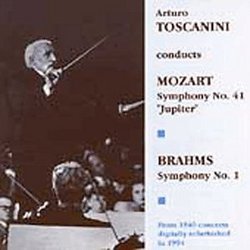| All Artists: Mozart, Brahms Title: Symphony 41/Symphony 1 Members Wishing: 1 Total Copies: 0 Label: Music & Arts Release Date: 1/24/1995 Genre: Classical Styles: Historical Periods, Classical (c.1770-1830), Symphonies Number of Discs: 1 SwapaCD Credits: 1 UPC: 017685083327 |
Search - Mozart, Brahms :: Symphony 41/Symphony 1
CD Details |
CD ReviewsThe Ultimate Toscanini "Jupiter" Symphony 09/18/1998 (5 out of 5 stars) ""Digitally refurbished in 1994" says the cover of this M&A CD. I always shudder when I see something like this on an historical compact disk, having been burned so often by engineering that adds horrible echoes, phase shifts, and inappropriate re-equalizations.But here we have only fine, clinical, and honest sound from the original monaural transcription disks, as close to them in lifelike reality as we are likely to hear! Huzzah!!And the revelation provided by this issue is that Toscanini's considered view of the Mozart "Jupiter", etched into the 1945 shellac disk recording now included on Volume 11 of the RCA / BMG Toscanini Collection, does not necessarily represent his best achievement with the piece. Robert C. Marsh and other critics have long felt that the 1945 recording was rushed and hectic, though I personally discovered that at least part of its intensity was due to the extra audio compression added to the mid-fifties Victor Red Seal LP pressing; my earlier late-forties vinyl 45 rpm set had wider dynamic range and less "stress" in the loud peaks, which seemed to have enhanced the spaciousness of the interpretation. The BMG CD issue resembles the 45 rpm, or the original shellacs, more than the compressed Victor LP.But this revelatory 20 April 1940 broadcast (mistakenly described on the back of the CD as being from '49) finds the Maestro in a more pensive and relaxed mood. Using an electronic metronome, I made some comparisons of tempo with the commercial release done 5 years later.1. Allegro Vivace: In 1940, Toscanini's opening tempo is much slower than the careening take-off of '45. He soon settles in at about 140-142 quarter-note beats per minute, though the pacing is very flexible and constantly varies around these values. In 1945, he charges off at about 150-52 and is less plastic and more martial. 2. Andante. Cantabile: The tempo of 93 to 95 in 1940 is raised to a fast 105 for the later commercial recording, and sounds far too quick: was the Maestro straining to get the movement on two sides of the 78 rpm set? Well, no, for it takes a total of 6:48 in 1945 (one side of a typical 78 could last from 4 and a half to just over 5 minutes) as opposed to 6:42 in 1940 (referring to the ACTUAL track playing times, not the incorrect indications on the RCA and M&A albums.) One finds a paradox: the earlier reading is SHORTER than the later, faster- sounding one: this is accomplished through the use of tempo rubato, varying the pace but centering the basic pulse around a specific tempo. Toscanini used this technique throughout his career, but tended to abandon it and revert to stricter tempi in the last decade. The earlier version is more flexible and natural in expression. 3. Menuetto. Allegro. Trio: The basic pulse in 1940 is about 148-9 quarter note beats per minute, speeded up to 151 or a bit faster in '45. Not too much difference, but it IS noticeable!4. Finale. Allegro Molto: In 1940, Toscanini plays the movement at a basic tempo centered around 149 to 150 quarter note beats per minute; in '45 he has accelerated to at least 156 or even faster! The orchestra has to scramble and, according to Marsh's analysis, plays many passages in an unclean manner.Throughout the 1940 reading, all is sunny relaxation and good humor. If this performance were more widely know, it might rehabilitate Toscanini's damaged reputation as a Mozart conductor who seemed to press too hard!The Brahms Symphony No. 1 was done at Carnegie Hall on 6 May 1940 and, like the Mozart, has good solid in-house acetate disk aircheck sound, though both have no highs above about 4.5 to 5 kHz and seem just a bit inferior in transparency to the great 1936 PSNY recording of the Beethoven Seventh. The Maestro's reading of the C Minor has gelled by 1940 into the solid, Germanic, and forthright presentation epitomized by his future commercial recordings, telecast, and broadcasts: it is arguably the finest interpretation of any of the NBC Firsts."
|

